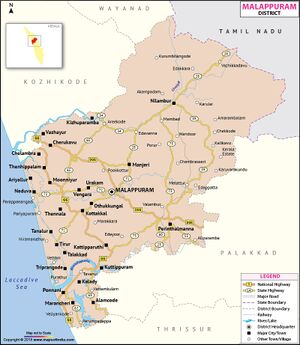Ponnani

Ponnani (पोन्नानी) is a town annd Taluk in Malappuram District, in the state of Kerala, India.
Contents
Variants
Location
It is situated at the estuary of Bharatappuzha (River Ponnani), on its southern bank, and is bounded by the Arabian Sea on the west and a series of brackish lagoons in the south. As of the 2011 Census, the municipality forms a part of Malappuram metropolitan area. National Highway 66, from to Panvel to Kanyakumari, passes through Ponnani Municipality. [1] The River Tirur joins River Ponnani at its mouth at Patinjarekkara Beach from the north bank, opposite to Ponnani. Ponnani is located 68 km south to Kozhikode city, 48 km southwest to Malappuram city, 91 km northwest to Palakkad city, and 50 km northwest to Thrissur city. Ponnani is located right in the middle of the Kerala coast.
Jat clans
History
In the Middle Ages, under the ambitious Hindu chiefs of Kozhikode (the Samutiris/Zamorins), Ponnani developed as one of the most important centers of Muslim trade - both overseas and domestic - on the Arabian Sea. The port also served as the military headquarters of the Kozhikode rulers. With the arrival of the Portuguese explorers in the late - 15th century, the city witnessed several battles between the Admirals of Kozhikode and the Portuguese for the monopoly in the Spice Trade. Whenever a formal war was broke out between the Portuguese and the Kozhikode rulers, the Portuguese attacked and plundered, as the opportunity offered, the port of Ponnani. The relentless battles lead to the eventual decline of the settlement, with the exodus of Middle Eastern merchants, and the rulers who protected it. Presently, Ponnani is one of the major fishing centers in Kerala.[2]
The original headquarters of the Perumbadappu Swaroopam, who later became the Kingdom of Cochin, was at Chithrakoodam in Vanneri, Perumpadappu, which is located 10 km south to Puthuponnani, in Ponnani taluk. When Perumpadappu came under the kingdom of the Zamorin of Calicut, the rulers of Perumpadappu fled to Kodungallur, and later they moved to Kochi, where they established the Kingdom of Cochin.
The city of Ponnani also provided ideological support for the battles against the Estado da Índia. It was the home of the revered Makhdum family. Prominent members of this Yemeni family of Islamic theologians included Zain-ud-Din Makhdum I (1467 - 1521) and his grandson Zain-ud-Din Makhdum II (1530 - 1581). Makhdum II is known for his formidable historical chronicle Tuhfat al-Mujahidin ("Glory to the Victory of Mujahidun", c. 1583), first printed and published in Lisbon. A copy of this edition has been preserved in the library of Al-Azhar University, Cairo.[3]
The Ponnani Jum'ah Masjid, also known as Valiya Jum'ah Palli/Makhdum Mosque, was built in the 16th century AD. Ponnani, once known as the "Little Mecca of Malabar" and the "Jami'at al-Azhar of Malabar", was a prominent center of Islamic learning. It is known that students from as far as Sumatra, Java and Sri Lanka traveled to Ponnani for their spiritual education.[4]
During the months of February and March, large number of migratory birds flock at Ponnani (both Ponnani and Patinjarekkara Beaches). Arabi Malayalam script, a script used to write Malayalam, was originated at Ponnani. The script was also known as "the Ponnani Script".[5] Bharathappuzha, also known as the Ponnani River, has contributed much to the Malayalam literature.
Pre-historical and Early Historical (2nd century BC – 3rd century AD) nature of this settlement is shrouded in mystery. Its location at estuary of the Bharatappuzha amidst the fertile plains suitable for rice cultivation might have attracted early settlers. It is known that the river mouth - situated opposite to the plains of Coimbatore across the Ghat mountains - was accessed by the rulers of central Tamil Nadu through the Palghat Gap. It is generally assumed that the archaic Tamil chiefs came into contact with Greco-Roman navigators at the mouth of the Bharatappuzha.[6]
Even in the latter times, Ponnani served as the major rice supplier to the Portuguese outposts in India. Throughout the Colonial rule, the Ponnani rice cargoes were shipped across the West Coast. Tobacco was the other major commodity exported from Ponnani to Goa.[7]
Nagavanshi History
Dr Naval Viyogi[8] writes.... The high[9] priest of the serpent cult in Malabar is the Pāmbanmākkād Nambudri who lives in the town of Ponnāni in a house full of cobras which are said to be harmless to his family.
External links
References
- ↑ Kerala Tourism
- ↑ A. Sreedhara Menon. Kerala History and its Makers. D C Books (2011)
- ↑ Roland E. Miller. Mappila Muslim Culture SUNY Press, 2015
- ↑ Roland E. Miller. Mappila Muslim Culture SUNY Press, 2015
- ↑ Kerala Tourism
- ↑ Rajan Gurukkal. Classical Indo-Roman Trade: A Misnomer in Political Economy.
- ↑ Celsa Pinto. Trade and Finance in Portuguese India: A Study of the Portuguese Country Trade, 1770-1840. Concept Publishing Company, 1994
- ↑ Nagas, The Ancient Rulers of India, Their Origins and History, 2002, p. 32
- ↑ Vogel JPH P-274